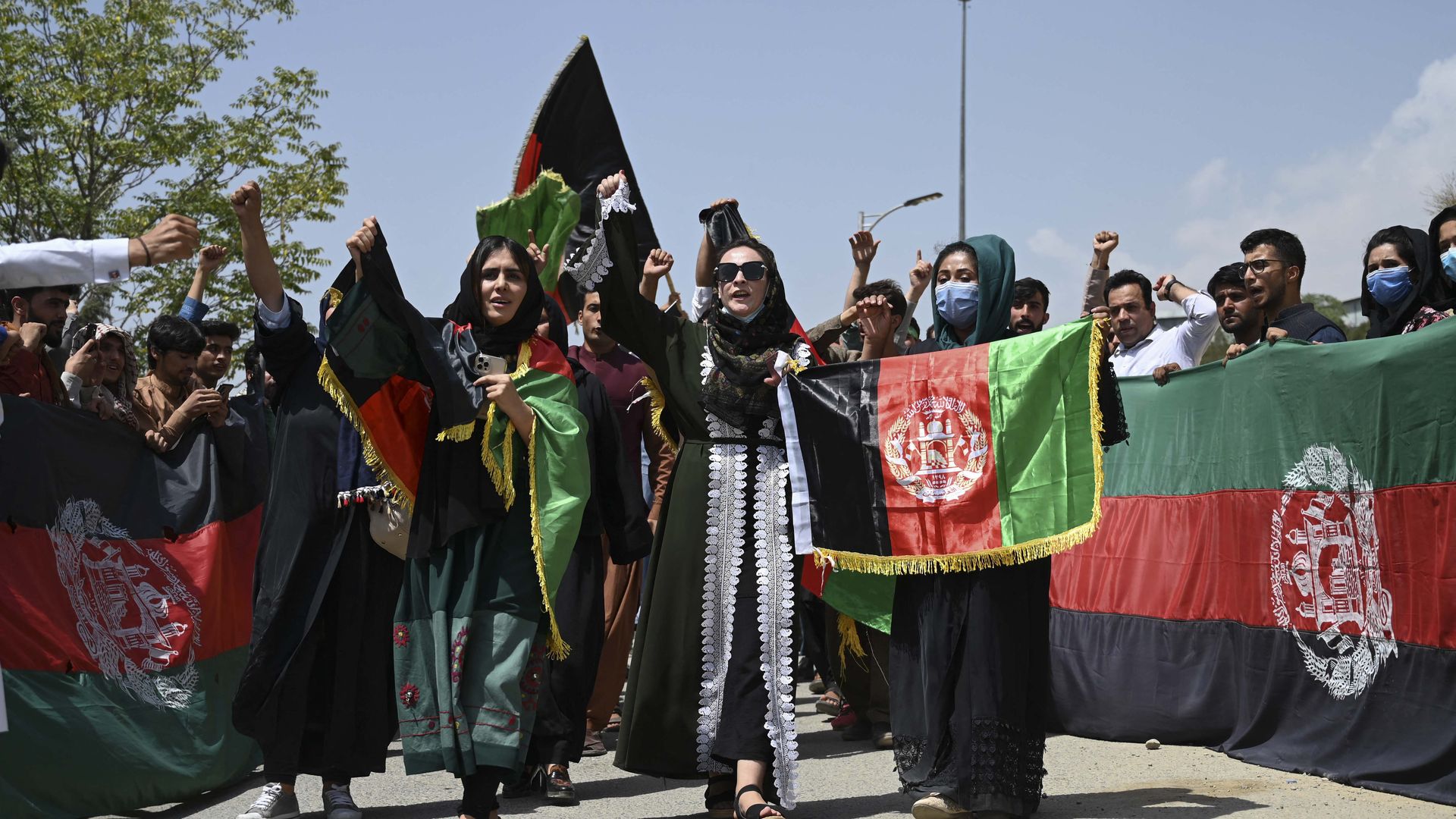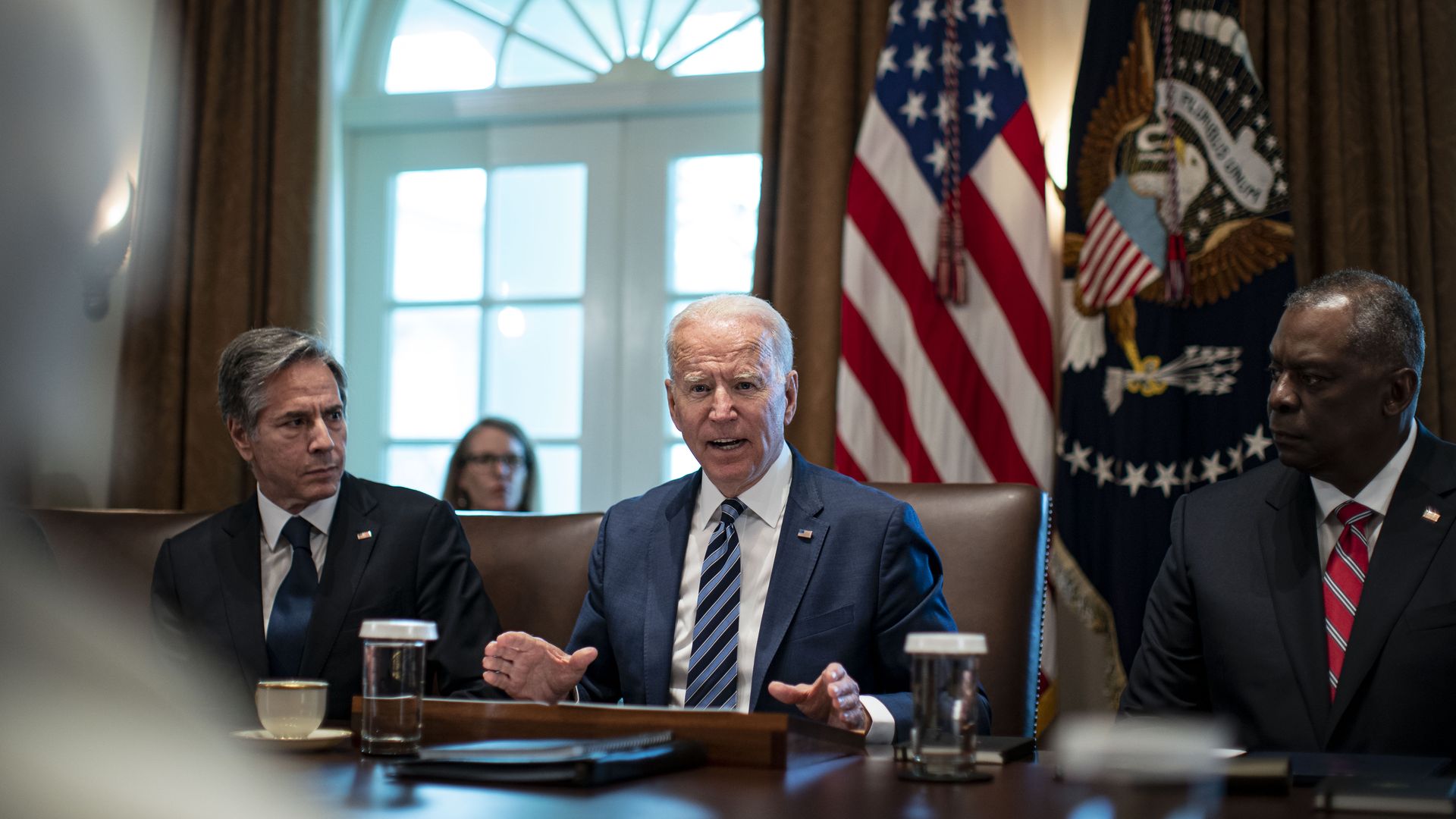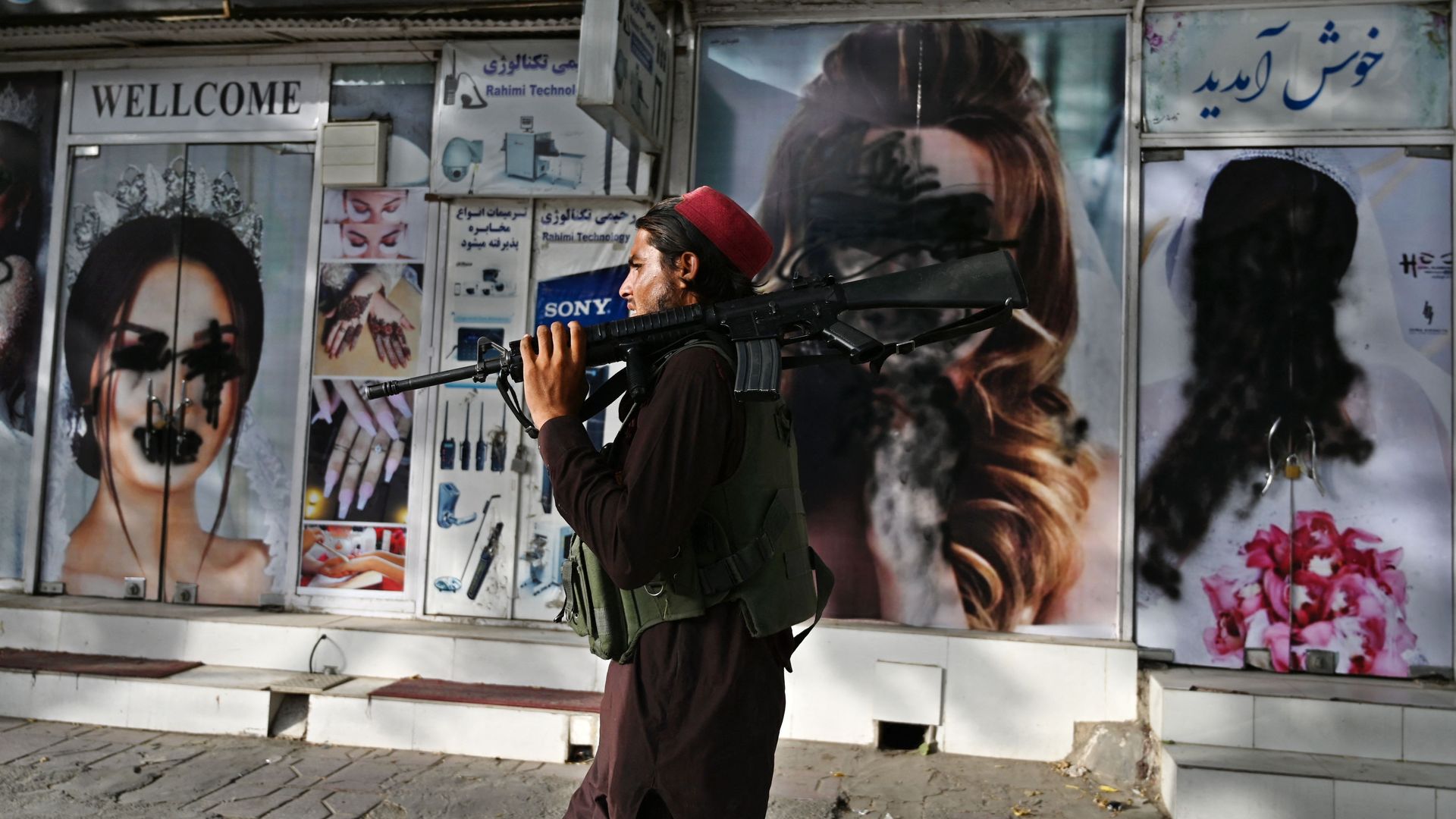| | | | | | | Presented By OurCrowd | | | | Axios World | | By Dave Lawler ·Aug 19, 2021 | | Welcome back to Axios World. - I've got something a little different planned for next week, but tonight's full edition (1,810 words, 7 minutes) is dedicated to helping you get up to speed on the events in Afghanistan.
- Please subscribe if you haven't yet, and tell a friend about this newsletter.
| | | | | | 1 big thing: The state of the airlift |  | | | Waiting for a flight out. Photo: Shakib Rahmani/AFP via Getty | | | | The U.S. is ramping up the airlift in Kabul but is still only using a fraction of its total capacity to evacuate Americans and Afghans. Breaking it down: The U.S. has enough aircraft available to meet its goal of getting 5,000–9,000 people out of the country each day, Gen. Hank Taylor told reporters, but it's only evacuated 7,000 people in total since Saturday — 2,000 of them in the previous 24 hours. - The airport remains secure and operational for now, but it's unclear how long that will remain the case.
- President Biden has said U.S. troops will remain until all Americans who wish to get out can, even if that's after Aug. 31. There are believed to be upward of 10,000 Americans still in the country.
- But that pledge does not apply to the tens of thousands of Afghans, many of whom worked with U.S. troops, who are now seeking refuge.
There are several snags in the airlift operation. - One is the difficulty of processing all of those who are at the airport. That effort sped up today, according to State Department spokesperson Ned Price, who said around 6,000 people had been approved and are now in the queue for evacuation.
- Another major hurdle is getting to the airport. The Taliban have agreed to offer safe passage to U.S. passport holders, and Americans have been urged to make their way to the airport, the State Department says.
- But multiple news organizations have reported that Afghans, including some with documentation from the U.S., have been turned away and even beaten at Taliban checkpoints. One Afghan interpreter told the BBC he'd tried on three separate occasions to travel to the airport but turned back each time due to the danger to his family.
Defense Secretary Lloyd Austin said on Wednesday that the U.S. forces lack the "capability" to pick up large numbers of Americans stranded in Kabul and bring them to the airport, and he said the U.S. did not plan to extend the safe zone beyond the airport. - That means the success of the operation hinges on the cooperation of the Taliban.
- Joint Chiefs Chair Gen. Mark Milley has said it will be the second-largest civilian airlift operation in U.S. history, after Saigon.
|     | | | | | | 2. Latest headlines: Taliban crack down on protests |  | | | Afghan women mark Independence Day in Kabul. Photo: Wakil Kohsar/AFP via Getty | | | | 1. Hundreds of protesters gathered in Kabul and other cities today, a holiday marking Afghanistan's independence following British rule, and waved the country's national flag in a show of defiance against the flag used by the Taliban. - Taliban fighters opened fire in the city of Asadabad, killing two people, and also cracked down on protests elsewhere.
2. Few women are on the streets of Kabul, WSJ reports, amid a climate of fear and uncertainty. - The Taliban have said women's rights will be respected within the bounds of Islamic law but offered no specifics. A spokesperson said today that women will have to wear the hijab but not the burka.
3. Away from the airport, reports have generally characterized Kabul as calm, without the bloodshed many feared if the city fell. - But one NGO has found, in a report to the UN, that the Taliban is going door to door to find people who worked with NATO forces or for the ousted government.
4. The Taliban have gained a massive war chest, complete with U.S.-made Humvees, planes, helicopters, night-vision goggles and drones. - The equipment includes over 2,000 armored vehicles, and up to 40 aircrafts, Reuters reports, citing an intelligence assessment.
5. The Biden administration has frozen Taliban central bank reserves held in the U.S., while the IMF has said Afghanistan won't receive a scheduled influx of cash because the country lacks an internationally recognized government. - Ajmal Ahmady, who was the central bank governor before fleeing the country, told the FT that the severing of international funding will contribute to an economic crisis that could cause refugee flows to Europe and elsewhere.
- For now, the Taliban's control of much of the world's opium supply will provide one large stream of funding.
|     | | | | | | 3. How we got here: Biden's withdrawal decision |  | | | Biden with Secretary of Defense Lloyd Austin (R) and Secretary of State Tony Blinken. Photo: Al Drago/Bloomberg via Getty | | | | When President Biden inherited the war in Afghanistan, he faced three broad policy options. - Comply with Donald Trump's deal and withdraw all U.S. troops by May 1.
- Modify Trump's deal by maintaining the commitment to withdraw but extending the timeline and, potentially, making it conditional on some sort of political agreement between the Afghan government and the Taliban.
- Reject Trump's deal and keep U.S. troops in the country indefinitely.
Biden opted for a combination of options 1 and 2, announcing that all U.S. troops would be leaving Afghanistan no matter what happened on the ground, but extending the timeline by four months to allow more time to execute the withdrawal. Criticism of Biden's decision to withdraw tended to fall into two buckets. - Some, like David Petraeus, who commanded the U.S war effort in Afghanistan, argued for a sustained U.S. presence of "a few thousands troops" to maintain some semblance of stability.
- Others criticized the fact that Biden was so definitive about withdrawal — undercutting U.S. leverage in pushing for a political settlement — and set a firm deadline, particularly the symbolic date of Sept. 11.
Biden and his aides have argued that past attempts to put conditions on withdrawal have resulted in no withdrawal at all, and that there was never going to be a "right time" to get out. - They've also argued that an outright rejection of Trump's deal would have brought the U.S. back into direct conflict with the Taliban — which had stopped firing at U.S. troops under Trump's deal — and would have ultimately required a much larger U.S. troop presence to sustain a war that was not winnable.
|     | | | | | | A message from OurCrowd | | OurCrowd helps you add top startups to your portfolio | | |  | | | | Problem: Startups are staying private longer, keeping investment growth behind closed doors. Solution: OurCrowd is changing that. They have 73K members and have invested $1B+ in companies like Lemonade and Beyond Meat — pre-IPO. Get in early on tomorrow's big deal - with OurCrowd. | | | | | | 4. How we got here II: Things fell apart. Fast |  | | | A Taliban fighter walks passed a vandalized beauty parlor in Kabul. Photo: Wakil Kohsar/AFP via Getty | | | | The swift collapse of Kabul may actually have given ballast to the argument that prolonging the U.S. troop presence in Afghanistan would only delay the inevitable — but it has also generated a new wave of criticism about the withdrawal strategy. Breaking it down: Much of that criticism has centered on the idea that the U.S. could and should have recognized that the Afghan army — low on both capability and morale with their salaries unpaid and their U.S. partners pulling out — might fold within weeks, not months or years. - Milley said Wednesday: "There was nothing that I or anyone else saw that indicated a collapse of this army and this government in 11 days."
- Biden has also said that he knew a Taliban takeover was possible, but not so quickly. He blamed a lack of will from Afghanistan's political and military leaders.
- Others have pointed fingers at U.S. intelligence for failing to anticipate the rapid collapse, at successive military leaders for overselling the progress in training the Afghan forces, or at Biden's own rhetoric and tactics around withdrawal for undercutting both the hope and the practical capabilities of the Afghan forces.
Worth noting: Many local officials in Afghanistan clearly saw the writing on the wall. They had been negotiating surrender deals with the Taliban for over a year, the Washington Post's Susannah George reports. |     | | | | | | Bonus: Where in the world |  | | | Screengrab via Apple Maps | | | | The city marked with the red pin is only a faint dot on this nighttime satellite image, but it's currently the center of international affairs. The three numbered cities, meanwhile, shine brightly enough to stand out from their surroundings. Can you name all four? Scroll to bottom for answer. |     | | | | | | 5. How we got here III: Missed opportunities |  | | | Awaiting evacuation tonight on a U.S. Air Force plane. Photo: Shakid Rahmani/AFP via Getty Images | | | | Another argument against Biden's handling of the withdrawal is that the U.S. should have moved more quickly to evacuate Americans, Afghans who worked with U.S. troops, and potentially Afghans who could now be in danger due to their activism, professions (women in media or politics, for example), or work with Western governments and organizations. - The scenes of chaos at Kabul's international airport have amplified claims of a mismanaged withdrawal, but Biden told ABC that chaos was always the inevitable result of a U.S. exit. He has also said that Afghan leaders, fearing mass panic, urged him not to conduct a large-scale evacuation earlier.
- Still, the U.S. is now reliant on the Taliban to ensure safe passage for Americans to the airport, which the administration says the group is providing. Afghans currently have no such protections.
- Further complicating efforts to evacuate Afghans is the massive backlog of Special Immigrant Visa (SIV) applications. Two senior administration officials tell Axios that the SIV process had stagnated under Trump and they'd been working since February to expedite the process, but those efforts had only just begun to bear fruit by the time Kabul fell.
Others argue that Biden should have kept Bagram Air Base open to conduct a more secure and efficient evacuation. - The U.S. abandoned the base near Kabul that had been the hub of its operations in Afghanistan six weeks ago. It was taken over by Afghan forces and then, on Sunday, by the Taliban.
- Milley contended that securing Bagram would have required more forces. So did securing the civilian airport, though, and Milley actually left open the possibility of retaking Bagram to expedite the evacuation process.
|     | | | | | | 6. What Kabul means for NATO |  | | | Tom Tugendhat speaks in Parliament. Photo: House of Commons/PA Images via Getty | | | | The existential crisis Donald Trump's election provoked within NATO seemed to end with the victory of Joe Biden, a fierce advocate of the trans-Atlantic alliance. - But another round of soul-searching is now underway in European capitals over the U.S. withdrawal from Afghanistan — negotiated by Trump with the Taliban and executed by Biden, all with hardly any input from Europe.
Flashback: NATO's first and only invocation of its Article 5 commitment to mutual defense came prior to the invasion of Afghanistan, and in many NATO countries — the U.K., for instance — the war has been as closely watched and hotly debated over the past two decades as in the U.S. - But when Biden reaffirmed Trump's decision to pull out, America's NATO allies, which collectively had more troops in the country than the U.S., had little choice but to follow suit.
- U.K. Defense Minister Ben Wallace, a vocal opponent of Biden's withdrawal decision, has said a few NATO countries discussed the possibility of keeping troops in Afghanistan, but decided it wouldn't be possible without the air support and other infrastructure provided by America.
What they're saying: That lack of agency figured heavily in a debate Wednesday on Afghanistan in the House of Commons. - "Did we just think we had to follow the United States and on a wing and a prayer it would be all right on the night?" former Prime Minister Theresa May asked.
- Tom Tugendhat, an Afghanistan veteran and chair of the parliamentary Foreign Affairs Committee, urged European NATO members to ensure "we are not dependent on a single ally, on the decision of a single leader."
Between the lines: The debate over European "strategic autonomy" that picked up steam under Trump has now taken on new relevance under Biden. What to watch: NATO foreign ministers will convene virtually tomorrow to discuss the evacuation efforts and next steps in Afghanistan. |     | | | | | | 7. Stories we're watching |  | | | The Tour of Spain passes through Molina de Aragón. Photo: Gonzalo Arroyo Moreno/Getty Images | | | - Haiti quake death toll tops 2,000 as anger grows over lack of aid
- Iran continues to produce uranium metal
- One case in New Zealand prompts lockdown
- Israel-Poland dispute on Holocaust property law
- Israeli PM to visit next week
- A Vietnamese refugee's message on Afghanistan
- In photos: America's longest wars
Quoted: "I've been hiding in my house with my family. No one is going outside. I still didn't get any news from SIV about my visa. ... I'm just waiting for them to give me answers so I can get out of this situation and get to safety with my family." — Najib, an Afghan interpreter, speaking to " Axios Today" |     | | | | | | A message from OurCrowd | | Meet the VCs that invested in Lemonade and Beyond Meat before the IPOs | | |  | | | | Global network of 73K+ members and 1000+ MNCs (from Honda to P&G and Travelers to Pepsico), OurCrowd accelerates startups' success. Typical rounds are $2-$20M, with opportunity for more alongside institutional investors. Take the next step to global success - with OurCrowd. | | | | Answers: Kabul (pin), Moscow (1), Ankara (2) and Nairobi (3). |  | | It'll help you deliver employee communications more effectively. | | | | | | Axios thanks our partners for supporting our newsletters. If you're interested in advertising, learn more here.
Sponsorship has no influence on editorial content. Axios, 3100 Clarendon Blvd, Suite 1300, Arlington VA 22201 | | | You received this email because you signed up for newsletters from Axios.
Change your preferences or unsubscribe here. | | | Was this email forwarded to you?
Sign up now to get Axios in your inbox. | | | | Follow Axios on social media:    | | | | | |
Post a Comment
0Comments